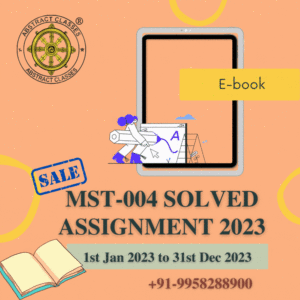
IGNOU BZYET-143 Solved Assignment 2024 | B.Sc. CBCS Zoology
₹49.00
Please read the following points before ordering this IGNOU Assignment Solution.
Share with your Friends
IGNOU BZYET-143 Assignment Question Paper 2024
bzyet-143-solved-assignment-2024-qp-f7c15420-900d-4a5d-a422-97852564b388
- i) Give two examples of insects for each of the following types of metamorphosis:
a) No metamorphosis:
b) Incomplete metamorphosis:
c) Complete metamorphosis:
ii) Give the different developmental stages in the following insects:
a) Silver fish:
b) Grass hopper: - a) Differentiate between:
i) Propagative Transmission and Cyclopropagative Transmission
ii) Cyclodevelopmental Transmission and Vertical Transmission
b) Answer the following questions:
i) Name the reduced hindwings of diptera and write their functions.
ii) How do mosquitoes detect their host for sucking of blood? - a) Name a hemimetabolous order which is exclusively parasitic. Explain its morphological features in brief.
b) Write the important features of Order Siphonaptera which make them important disease vectors. - Write short notes on the following:
a) Prevention / control measures of fleas.
b) Typhus fever
c) Tunga penetrans
d) Yersinia pestis transmission - a) Distinguish between the following:
i) Pediculus humanus corporis and Pediculus humanus capitis
ii) Male and Female body louse
b) Explain the role of Reduviid bug as a biological vector in the transmission of Chagas disease. - a) Explain the epidemiology of malarial parasite.
b) Discuss the preventive and control measures of Anopheles mosquito. - Draw a labeled diagram of:
a) Life cycle of JE
b) Filarial worm transmission Cycle - Give difference between the following:
a) Extrinsic incubation period and intrinsic incubation period
b) Transverse and vertical transmission
c) Urban cycle and sylvatic cycle - Write short notes on:
a) Traps used for controlling houseflies
b) Cultural control of Musca
c) Chemical control of housefly
d) Myiasis - a) Explain the concept of Integrated Vector Management.
b) How can the disease vectors be genetically manipulated to reduce their population?
BZYET-143 Sample Solution 2024
bzyet-143-solved-assignment-2024-ss-020cab3d-1c01-486f-9bdf-7506d86b97ee
- i) Give two examples of insects for each of the following types of metamorphosis:
a) No metamorphosis:
b) Incomplete metamorphosis:
c) Complete metamorphosis:
- Insects in this category do not undergo significant changes in body form as they develop from nymphs to adults. They simply grow larger.
- Examples:
- Silverfish (Lepisma saccharina): These primitive insects have a carrot-shaped body and are commonly found in damp, dark areas.
- Bristletails (Order: Archaeognatha): These are small, wingless insects with elongated bodies and three long tail filaments.
- Insects with incomplete metamorphosis undergo three life stages: egg, nymph, and adult. The nymphs resemble the adults but lack fully developed wings and reproductive structures.
- Examples:
- Grasshoppers (Order: Orthoptera): Grasshopper nymphs look like miniature adults and gradually develop wings as they molt.
- Cockroaches (Order: Blattodea): Cockroach nymphs are wingless and smaller than adults but share a similar body shape.
- Insects with complete metamorphosis undergo four distinct life stages: egg, larva, pupa, and adult. The larval stage looks entirely different from the adult, and the transformation occurs during the pupal stage.
- Examples:
- Butterflies (Order: Lepidoptera): Butterfly larvae are caterpillars that feed and grow before entering the pupal stage (chrysalis) and emerging as winged adults.
- Beetles (Order: Coleoptera): Beetle larvae, often called grubs, undergo metamorphosis inside a pupal case and emerge as adult beetles with hardened exoskeletons and wings.
a) Silver fish:
b) Grass hopper:
- Egg: Silverfish lay eggs in crevices or hidden areas. The eggs are oval-shaped and whitish.
- Nymph (Young): After hatching, silverfish emerge as nymphs, which resemble smaller versions of the adults. They lack scales, which develop as they mature.
- Adult: Nymphs molt several times as they grow, eventually becoming adults with silvery scales and a tapered, carrot-shaped body. Silverfish continue to molt throughout their lives, even after reaching adulthood.
- Egg: Grasshoppers lay eggs in the soil or plant tissue. The eggs are typically laid in clusters called pods.
- Nymph (Young): After hatching, grasshoppers emerge as nymphs, which look like small, wingless versions of the adults. Nymphs go through several instars (developmental stages between molts), during which they grow larger and gradually develop wing buds.
- Adult: After the final molt, the nymphs transform into adults with fully developed wings and reproductive organs. Adult grasshoppers are capable of flight and reproduction.
- a) Differentiate between:
i) Propagative Transmission and Cyclopropagative Transmission
ii) Cyclodevelopmental Transmission and Vertical Transmission
- Propagative Transmission: In this type of transmission, the pathogen multiplies within the vector without undergoing any developmental changes. The vector acquires the pathogen, which then propagates (increases in number) within the vector before being transmitted to the next host. This is common in viral transmissions, such as the transmission of the West Nile virus by mosquitoes.
- Cyclopropagative Transmission: This involves both multiplication and development of the pathogen within the vector. The pathogen undergoes a cycle of changes, including both propagation and morphological or physiological development, before it becomes infective to the next host. An example is the transmission of malaria parasites (Plasmodium spp.) by Anopheles mosquitoes, where the parasites undergo asexual multiplication and sexual development within the mosquito before they can infect humans.
- Cyclodevelopmental Transmission: In this type of transmission, the pathogen undergoes developmental changes within the vector but does not multiply. The pathogen changes its form or undergoes a necessary part of its life cycle within the vector before it can be transmitted to the next host. An example is the transmission of filarial worms (e.g., Wuchereria bancrofti) by mosquitoes, where the larvae develop into infective stages in the mosquito but do not multiply.
- Vertical Transmission: This refers to the transmission of a pathogen from an infected parent directly to its offspring. Vertical transmission can occur through the placenta (transplacental), during childbirth (perinatal), or through breast milk (postnatal). An example is the transmission of HIV from an infected mother to her child during pregnancy, childbirth, or breastfeeding.
Frequently Asked Questions (FAQs)
You can access the Complete Solution through our app, which can be downloaded using this link:
Simply click “Install” to download and install the app, and then follow the instructions to purchase the required assignment solution. Currently, the app is only available for Android devices. We are working on making the app available for iOS in the future, but it is not currently available for iOS devices.
Yes, It is Complete Solution, a comprehensive solution to the assignments for IGNOU. Valid from January 1, 2023 to December 31, 2023.
Yes, the Complete Solution is aligned with the IGNOU requirements and has been solved accordingly.
Yes, the Complete Solution is guaranteed to be error-free.The solutions are thoroughly researched and verified by subject matter experts to ensure their accuracy.
As of now, you have access to the Complete Solution for a period of 6 months after the date of purchase, which is sufficient to complete the assignment. However, we can extend the access period upon request. You can access the solution anytime through our app.
The app provides complete solutions for all assignment questions. If you still need help, you can contact the support team for assistance at Whatsapp +91-9958288900
No, access to the educational materials is limited to one device only, where you have first logged in. Logging in on multiple devices is not allowed and may result in the revocation of access to the educational materials.
Payments can be made through various secure online payment methods available in the app.Your payment information is protected with industry-standard security measures to ensure its confidentiality and safety. You will receive a receipt for your payment through email or within the app, depending on your preference.
The instructions for formatting your assignments are detailed in the Assignment Booklet, which includes details on paper size, margins, precision, and submission requirements. It is important to strictly follow these instructions to facilitate evaluation and avoid delays.
Terms and Conditions
- The educational materials provided in the app are the sole property of the app owner and are protected by copyright laws.
- Reproduction, distribution, or sale of the educational materials without prior written consent from the app owner is strictly prohibited and may result in legal consequences.
- Any attempt to modify, alter, or use the educational materials for commercial purposes is strictly prohibited.
- The app owner reserves the right to revoke access to the educational materials at any time without notice for any violation of these terms and conditions.
- The app owner is not responsible for any damages or losses resulting from the use of the educational materials.
- The app owner reserves the right to modify these terms and conditions at any time without notice.
- By accessing and using the app, you agree to abide by these terms and conditions.
- Access to the educational materials is limited to one device only. Logging in to the app on multiple devices is not allowed and may result in the revocation of access to the educational materials.
Our educational materials are solely available on our website and application only. Users and students can report the dealing or selling of the copied version of our educational materials by any third party at our email address (abstract4math@gmail.com) or mobile no. (+91-9958288900).
In return, such users/students can expect free our educational materials/assignments and other benefits as a bonafide gesture which will be completely dependent upon our discretion.
Related products
-
IGNOU Assignment Solution
IGNOU MEG-16 Solved Assignment 2022-2023 | MEG | Indian Folk Literature
₹101.00 Go to the App -
IGNOU Assignment Solution
IGNOU MEG-12 Solved Assignment 2022-2023 | MEG | A Survey Course in 20th Century Canadian Literature
₹101.00 Go to the App -
IGNOU Assignment Solution
IGNOU MEG-11 Solved Assignment 2022-2023 | MEG | AMERICAN NOVEL
₹101.00 Go to the App




